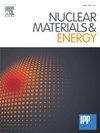Modelling of the X-point radiator configuration in DTT with SOLEDGE2D-Eirene
IF 2.3
2区 物理与天体物理
Q1 NUCLEAR SCIENCE & TECHNOLOGY
引用次数: 0
Abstract
This work studied the feasibility of an X-point radiator (XPR) in the DTT single-null full-power scenario using the edge modelling code SOLEDGE2D-EIRENE. It predicts that the XPR is accessible in DTT using neon as seeding impurity; the accessibility to the configuration is compatible with the reduced model developed for ASDEX Upgrade and TCV. The formation of the X-point radiator in DTT leads to strong impurity and temperature redistribution with respect to standard detached plasmas and the formation of a cold volume with T as observed in other machines. The transition is sudden and had major consequences on pumping, neutral penetration and separatrix temperature. The operational window in impurity concentration between XPR formation and the plasma radiative collapse was estimated to be large. A strong bifurcation is observed at the XPR onset; the bifurcation allows for impurity seeding and concentration reduction after the XPR on-set even lower than in non-XPR standard detached cases.
求助全文
约1分钟内获得全文
求助全文
来源期刊

Nuclear Materials and Energy
Materials Science-Materials Science (miscellaneous)
CiteScore
3.70
自引率
15.40%
发文量
175
审稿时长
20 weeks
期刊介绍:
The open-access journal Nuclear Materials and Energy is devoted to the growing field of research for material application in the production of nuclear energy. Nuclear Materials and Energy publishes original research articles of up to 6 pages in length.
 求助内容:
求助内容: 应助结果提醒方式:
应助结果提醒方式:


